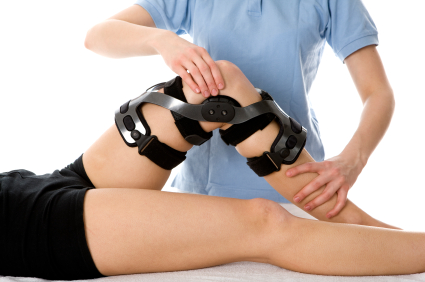Tears of the anterior cruciate ligament (ACL) get lots of attention in sports, and there are some very clear reasons why: these injuries are extremely common and usually put athletes on the sidelines for long periods. Discussions about ACL tears often focus on the severity of the damage to the knee and the timetable for when an athlete will get back on the field or court. But one thing that can get overlooked is the athlete’s risk for re-injury after they return, which can be fairly high in certain populations—especially young athletes. To ensure a successful recovery and avoid additional ACL tears, we strongly encourage completing a rehabilitation program in New York City.
The ACL is one of the four main ligaments within the knee that connects the tibia (shinbone) to the femur (thighbone). It runs diagonally in the middle of the knee and prevents the tibia from sliding forward on the femur, and it also provides a great deal of stability for the knee that keeps it from rotating out of position.
Injuries to the ACL can range in severity, but most are partial or complete tears. ACL tears are devastating injuries, and typically lead to significant pain, instability, swelling, tenderness, and muscle weakness. As a result, patients are often sidelined from physical activities for several months. Athletes and active individuals of just about any age can experience an ACL tear, but the chances are highest in those who participate in high-demand sports that involve lots of cutting motions, like basketball, soccer, football, and volleyball. In fact, about 1 of every 60 athletes will tear their ACL at some point in their career, and this figure is only expected to rise due to the increased intensity and growing participation in sports.
For most athletes that plan to continue playing sports, a surgical procedure called ACL reconstruction is often recommended as the best available option. The procedure does not repair the damaged ligament but instead creates a new one using other tissue from the leg (usually a tendon). ACL reconstruction is usually successful, and many athletes can return to their sport afterwards, but there are also some potential complications, like tearing the newly reconstructed ligament or the ACL or the other knee.
There are many factors that may be responsible for these additional injuries, but research has shown that younger athletes and those who return to high-risk sports are at a particularly high risk of re-injury. One study found that almost 25% of individuals under the age of 25 who return to a high-risk sport with lots of pivoting and cutting will either re-injure the reconstructed ACL or the opposite ACL.
Undergoing rehabilitation in New York City will minimize re-injury risk
For an ACL reconstruction surgery to be successful, a patient must allow enough time for the new ligament to become part of the knee (a process called graft incorporation) and restore the normal muscle strength of the knee to ensure it is properly protected. For this reason, physical therapy is essential to help patients get back to their pre-injury levels and not return to sports until they have completely recovered. Our rehabilitation program in New York City will guide you every step of the way, identify any potential issues, and address them with comprehensive interventions that will all reduce the risk of ACL re-tears in the future. Each ACL rehabilitation program may vary from patient to patient, but common elements include the following:
- Strengthening exercises to build back up the weakened muscles of the leg
- Stretching exercises to increase flexibility and regain normal mobility that may have been lost during the injury and surgery
- Plyometrics, or jump training, which are crucial for patients recovering from ACL tears
- Recommendations on how to modify your activities to minimize the risk for future injuries
- Exercises to improve neuromuscular control, which is the body’s ability to stay in a strong and stable position regardless of what movement it’s making
ACL tears are rough injuries that can have a significant impact on an athlete’s career, but the situation can be made far worse if another ACL tear is sustained after returning to play. This is why it’s crucial to take your recovery seriously, complete all the necessary steps, and never return to play until you’ve been cleared to do so. Dynamic Sports Physical Therapy can help during this process with a comprehensive rehabilitation program in New York City that takes these factors into consideration. Contact us at 212-317-8303 to schedule an appointment today, or click here for more information on ACL re-tears.

